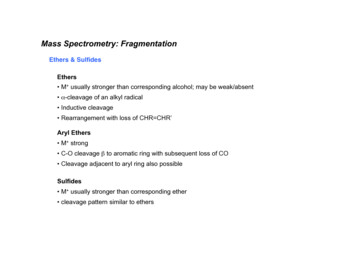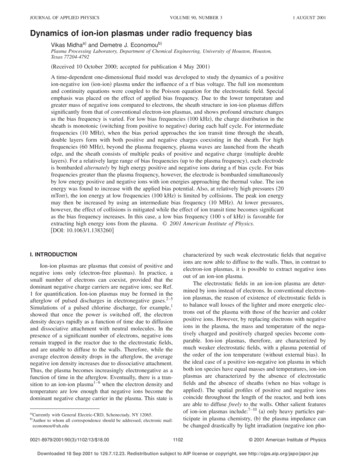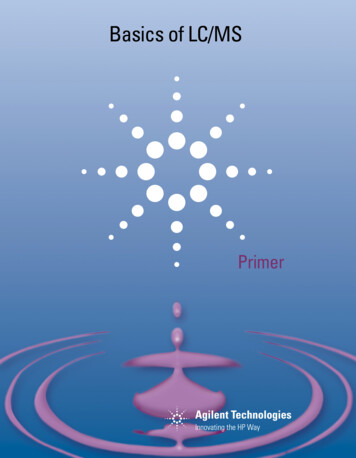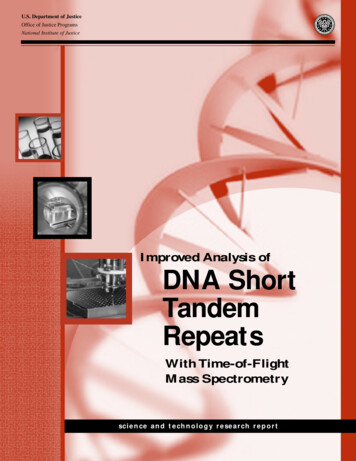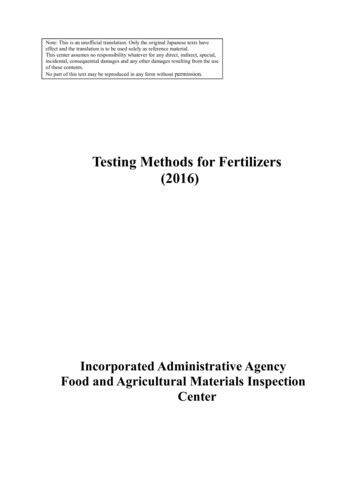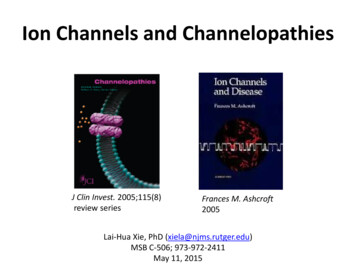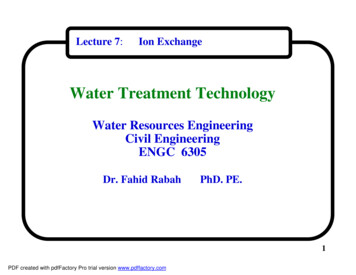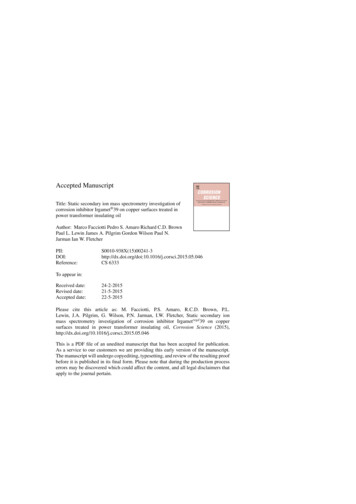
Transcription
Accepted ManuscriptTitle: Static secondary ion mass spectrometry investigation ofcorrosion inhibitor Irgamet 39 on copper surfaces treated inpower transformer insulating oilAuthor: Marco Facciotti Pedro S. Amaro Richard C.D. BrownPaul L. Lewin James A. Pilgrim Gordon Wilson Paul N.Jarman Ian W. p://dx.doi.org/doi:10.1016/j.corsci.2015.05.046CS 6333To appear in:Received date:Revised date:Accepted date:24-2-201521-5-201522-5-2015Please cite this article as: M. Facciotti, P.S. Amaro, R.C.D. Brown, P.L.Lewin, J.A. Pilgrim, G. Wilson, P.N. Jarman, I.W. Fletcher, Static secondary ionmass spectrometry investigation of corrosion inhibitor Irgametregd 39 on coppersurfaces treated in power transformer insulating oil, Corrosion Science 046This is a PDF file of an unedited manuscript that has been accepted for publication.As a service to our customers we are providing this early version of the manuscript.The manuscript will undergo copyediting, typesetting, and review of the resulting proofbefore it is published in its final form. Please note that during the production processerrors may be discovered which could affect the content, and all legal disclaimers thatapply to the journal pertain.
Highlights SSIMS was used to study corrosion inhibition of copper treated in insulating oil. Desorption experiments allowed the study of the inhibitor stability in vacuum. The energy of desorption of tolyltriazole under SSIMS conditions was calculated.AcceptedManuscript SSIMS imaging was shown to be an applicable new diagnostic tool for transformers.1Page 1 of 29
Static secondary ion mass spectrometry investigation of corrosioninhibitor Irgamet 39 on copper surfaces treated in power transformerinsulating oiliptMarco Facciotti*a, Pedro S. Amarob, Richard C. D. Brown*a, Paul L. Lewinb, James A. Pilgrimb, GordonWilsonc, Paul N. Jarmanc and Ian W. FletcherdDepartment of Chemistry, University of Southampton, Southampton SO17 1BJ, UK.bTony Davies High Voltage Laboratory, University of Southampton, Southampton SO17 1BJ, UK.cNational Grid, National Grid House, Warwick Technology Park, Gallows Hill, Warwick CV34 6DA, UK.dIntertek Wilton, The Wilton Centre, Redcar TS10 4RF, UK.*E-mail: facciotti.marco@gmail.com; R.C.Brown@soton.ac.ukanPhone: 44(023) 8059 4108uscraAddress: Department of Chemistry, University of Southampton, University Road, Highfield, SouthamptonMSO17 1BJ, UK.dAbstractStatic secondary ion mass spectrometry was used to study the corrosion inhibitor Irgamet 39 on the surface oftecopper treated in insulating oils and the effect of temperature changes, by means of temperature programmeddesorption experiments under vacuum, on metal coverage. Four commercial oils, both corrosive and non-Accepcorrosive, showed no significant influence on the stability of the tolyltriazole layer and the energy of its maindesorption event from copper was calculated around 100 kJ mol–1. Finally, an example of ion imaging asdiagnostic tool to track the distribution of corrosion inhibitor and by-products in decommissioned or failedpower transformers is described.Highlights SSIMS was used to study corrosion inhibition of copper treated in insulating oil. Desorption experiments allowed the study of the inhibitor stability in vacuum. The energy of desorption of tolyltriazole under SSIMS conditions was calculated. SSIMS imaging was shown to be an applicable new diagnostic tool for transformers.KeywordsA. copper; A. organic coatings; B. SIMS; C. sulphidation.2Page 2 of 29
IntroductionThe field of high voltage engineering has its origins in the requirement for high performance of electricaldistribution networks, which face continually growing demands for capacity and resilience. Every electricaldistribution network relies on some strategic assets such as transformers. Most transformers in use todayiptthroughout the world are filled with mineral oil, complying with international standards (e.g. IEC 60296), forthe dual purpose of providing electrical insulation and cooling of the copper conductors [1,2]. Sulphidemediated corrosion of copper and its alloys is a known issue in many applications of metallic materials, stillcrsubject of interest of the corrosion scientific community in both aqueous [3–6] and non aqueous environment[7–10]. In fact, previous studies have shown how certain organic compounds containing sulphur (e.g. dibenzylusdisulphide, DBDS) [11] are able to chemically attack copper surfaces immersed in insulating mineral oilcausing metal displacement, promoted by oxygen, together with the formation of corrosive by-products suchas copper sulphides (CuxS) [12–15]. Copper sulphides, being ionic compounds, can interfere with theaninsulation system (solid and liquid components) reducing its reliability; this can result in catastrophic failure ofhigh voltage assets, power distribution disruption and, ultimately, reputational and financial losses [16–18]. ToMprotect these valuable and essential pieces of equipment from ‘corrosive sulphur’ species the most commonprevention and mitigation strategy is the addition of an organic corrosion inhibitor to the oil [2,19].A corrosion inhibitor is a molecule, which binds to metallic surface with high affinity, capable of retarding ordpreventing attack of corrosive compounds [20]. Benzotriazole (BTA) and its derivatives are among the mosteffective copper corrosion inhibitors [10,21–24]. The protective film formed by BTA derivatives on coppertesurfaces may function both as a physical barrier to ionic or reactive species, and to attenuate copperdissolution [25]. Evidence of the presence of tolyltriazole on copper treated in oil was previously shown usingAccepTime of Flight Secondary Ion Mass Spectrometry (ToF-SIMS) [26,27], but contextual estimation of itsthermal stability were never reported.The addition of an organic corrosion inhibitor is preferred, in power transformer applications, over othermitigation strategies (e.g. oil reclamation, selective depolarization or substitution) due to its efficacy andrelatively low cost [2,28]. Irgamet 39, a mixture of methyl-BTA isomers (Figure 1), is the most widely usedcorrosion inhibitor to protect copper conductors [29]. It comprises a methyl-BTA (tolyltriazole) moiety and asecondary aliphatic amine moiety; the first is actively involved in the protection, after being released via retroMannich reaction [19,29], whilst the latter serves to solubilize the tolyltriazole in the oil (Fig. 1). Uponaddition of the corrosion inhibitor any damage to the copper surfaces or contamination of the oil or paperinsulation remain unchanged, although further degradation may be prevented [19].In fact, organic inhibition of copper is not a permanent solution and degradation of corrosion inhibitorperformance is a well-known issue, due to the effects of high temperatures and chemical reactions [30].Literature studies of the thermal and chemical stability of BTA derivatives on copper surfaces in oil indicatesome divergence of opinions. In common with other BTA derivatives, Irgamet 39 is known to undergo somedegradation in the presence of hydroperoxides, most likely formed via hydrocarbon peroxidation reactions.3Page 3 of 29
However, some researchers consider this degradation mechanism almost insignificant in transformers [19,29].Empirical studies reported effective corrosion inhibition even under the worst simulated operational conditions[16,31]. On the other hand, others concluded that the same severe thermal conditions that promote theformation of the corrosion by-products (i.e. copper sulphides), also promote the degradation of tolyltriazolebased corrosion inhibitors, rendering them ineffective [32]. Effective corrosion inhibition strongly depends oniptthe quality of the metal surface, therefore it was postulated that a corroded copper surface may exhibit reducedadsorption [33]. In any case, the long-term effectiveness of such inhibition still remains unknown [2,34], and itshould only be considered as a mitigation strategy.crHerein we report the results of a study towards the evaluation of temperature programmed desorption staticsecondary ion mass spectrometry (TPD-SSIMS) as analytical tool to study corrosion inhibition of copperussurfaces produced in insulating oil environments. This technique is particularly well-suited to the study oforganic overlayers at metal surfaces due to its unique molecular selectivity, through the observation of emittedmolecular or fragment ions characteristic of the organic corrosion inhibitor molecule [35]. In the presentanstudy, desorption of the corrosion inhibitor is conveniently visualised as a series of colour-coded imagescollected as the samples undergo a controlled heating ramp across a range of temperatures. These desorptionMdata together with theoretical calculations of the binding energies allow estimation of the thermal stability anddesorption behaviour of the corrosion inhibitor under vacuum. Finally, an application of SSIMS imaging totrack the distribution of corrosion inhibitor and corrosion by-products on copper taken from a scrappedteMaterials and methodsdtransformers is provided.AccepSolution and surface preparationOils used were Base oil 20 (SPEXCertiPrep, Inc.) and the three commercial transformer naphtenic mineral oilsNytro Gemini X (Nynas AB), HyVolt III (Ergon Inc.) and Nytro 10GBN (Nynas AB). Gemini X and HyVoltIII are inhibited mineral oils while 10GBN is uninhibited and naturally corrosive, characterised by typicalaromatic content of 3%, 9% and 14% respectively. All oils were free from detectable DBDS and corrosioninhibitors and were used without degassing. Typically, they show water content 30 ppm and acidity 0.01mg KOH g–1.All oil samples at 100 ppm (concentration commonly used in industry [28]) of Irgamet 39 (BASF) wereprepared using dilutions, by weight, of the respective stock solutions at 1000 ppm. Stock solutions wereprepared from 50 g of each oil with the addition of 50 mg of Irgamet 39. Final solutions were the result of a1:10 dilution, by weight, to 10 g. Oxygen free high conductivity (OFHC, Siemens) copper transformerconductor samples were used. Copper samples, were cut to a size of 100 mm2 and unwrapped to remove thelayers of insulating paper immediately before the start of the experiment. Copper samples were then washedwith fresh cyclohexane and placed in 20 mL headspace glass vials containing the oil solutions, closed with4Page 4 of 29
butyl/PTFE septa crimp seals and treated at 70 C for 24 hours in a fan oven. The solvent rinse prior to theexperiment was deemed necessary to thoroughly degrease the metal surface from contaminants, avoiding itsexposure to an aqueous environment. Samples were then removed from the oil, washed three times with freshcyclohexane to remove all oil traces and stored in screw-top glass vials. New glass vials and disposablepipettes were used during the sample preparation, all handling was performed with clean nitrile gloves andiptstainless steel tweezers at all times.TPD-SSIMS analysiscrSamples described in this work were analyzed by Static SIMS using the Ion-ToF ‘ToFSIMS IV’ instrument.The copper samples were attached to a suitable sample holder using clean metal clips. The samples forusanalysis were handled using clean stainless steel tweezers at all times. For the SSIMS work, positive andnegative ion spectra were recorded with 200 μm x 200 μm analysis areas. The total ion dose for eachacquisition was 5 x 1011 ions cm–2. This was within the accepted ion dose limit for static SIMS of 5 x 1012anions cm–2. The Bi32 ion source was used in all cases reported. Data were recorded from the samples using the‘bunched’ mode of operation. The spatial resolution achieved in the images was 4 μm and the massMresolution, m/Δm, was around 5000. Reference spectra for the liquid samples were collected by analyzing thepure liquid spread as a thin layer on clean PET film. Samples for thermal desorption analysis were mountedindividually on to a 'main chamber heating/cooling' sample holder under a clean Mo grid (see SupplementarydMaterial). The thermocouple used to measure the sample temperature was trapped between the sample surfaceand the underside of the Mo grid. For the thermal desorption work, the sample was stabilized at the startingtetemperature of 27 C (300 K) for approximately 10 minutes. The profile acquisition was started and thetemperature ramp (5 degrees per minute) began after 20 s acquisition time. The profiling was stoppedAccepmanually at 400 C (673 K). The main chamber pressure during analysis was less than 5 x 10–7 mbar from abase pressure of 5 x 10–9 mbar. Negative ion thermal desorption profiles, images and spectra were recordedfrom fresh areas of the samples using a 500 μm2 analysis area in each case. The total ion dose for each profilewas 2 x 1012 ions cm–2, which was within the accepted ion dose limit for static SIMS of 5 x 1012 ions cm–2.Data were recorded from the samples using the ‘bunched’ mode of operation. The spatial resolution achievedin the images was 4 μm and the mass resolution, m/Δm, was around 5000. The profiles and images wererecorded using the 'raw' data stream mode (RAW).Energy of Desorption (Edes) calculationsData were reprocessed in order to plot intensity vs. time for the representative ion at m/z –132. Data wereexported from the instrument 'IonSpec' software in ASCII format and then processed using Excel2000 andOrigin 9.1. 5 points FFT and adjacent averaging smoothing (100 points) was used to reduce the data noise atlow temperature and the first derivative plots were obtained. Data processing details can be found in theSupplementary Material. The temperature at maximum desorption rate (Tp) is then used to calculate the energy5Page 5 of 29
of desorption into vacuum (Edes) assuming a first order process and absence of intramolecular interactions andre-adsorption. The equation used is shown below [36].(Eq. 1)iptwhere B is the heating rate (5 K min–1 0.08333 K s–1) and vi is the rate constant (1013 s–1).Results and discussionInitially, to establish an experimental routine, a clean base oil model system (Base Oil 20) was used.crAdditionally, three representative commercial insulating oils used in high voltage power transformers wereinvestigated: Nytro Gemini X, HyVolt III and Nytro 10GBN (known to be corrosive). Secondary ion massusspectra collected from the oil samples were consistent with highly refined oil products for insulatingapplications. Although a significant part of the results shown here are from samples treated in Gemini X, theandiscussion can be extended to all other samples. The complete set of results for all samples can be found in theSupplementary Material.MTPD-SSIMS profilesFor each of the samples, an intensity profile of the major secondary ions of interest was obtained across thetemperature range and their complete mass assignment is available in the Supplementary Material. Secondarydion temperature desorption profiles for copper treated with 100 ppm of Irgamet 39 in Gemini X are presentedin Fig. 2 and Fig. 3. The relative secondary ion yield from the surface of the sample was observed to varytesignificantly with increasing temperature. Low amounts of 63Cu– ions are observed to be steadily emitted fromthe metal substrate across the entire range of temperatures investigated (Fig. 2). Chloride ion, fromAccepenvironmental contamination of the metal, is observed to be substantially depleted at ca. 100 C. A similarprofile is observed for Cu(CN)2– ions, formed through combination of ionised/excited Cu atoms with organicfragments of the corrosion inhibitor. Conversely, cyanide ion is observed to increase above 100 C, suggestingthe breakdown of Cu(CN)2–, decreasing again above ca. 130 C as the corrosion inhibitor is depleted (Fig. 2).More interesting and relevant to the study of corrosion inhibition of copper in insulating oils are ions directlyrelated to Irgamet 39 (Fig. 3). The molecular ion in negative polarity mode representative of the surface-activemoiety of the corrosion inhibitor molecule ([M–H]–) is a deprotonated tolyltriazole at m/z –132, [C7H6N3]–,which is also the most abundant ion in the set followed by its main fragmentation product at m/z –68,[C2H2N3]–, a deprotonated triazole. Interestingly, metaphosphate ion ([PO3]–), indicative of the presence ofoxidized phosphorus on the metal surface, was also observed for all oil-treated samples, and was thepredominant ion for samples treated in Base Oil 20. The source of these oxidized P-containing species is likelydue to blending of phosphorus-based secondary antioxidants, such as triarylphosphite-based hydroperoxidedeactivators commonly used in lubricant and polymer applications [37]. Indeed, SIMS analysis on all samplestreated in transformer oils showed traces of characteristic ions for tris(2,4-di-tert-butylphenyl) phosphite, againhighlighting the power of the technique. Base Oil 20 did not show specific markers for the presence of such6Page 6 of 29
species although, as every base oil product subject to severe hydro treatment that destroys any naturalinhibition, it is far more likely to contain antioxidant additives [38]. Regardless of their origin, oxidized Pcontaining species are present on the surface of copper following exposure to the oils.For most samples it was possible to see at least two distinct desorption events for tolyltriazole (m/z –132 andm/z –68, Fig. 4), which could indicate desorption from different copper sites as temperature increases (e.g.iptcrystallographic facets).Although it is not possible to provide a quantitative measurement of the amount of corrosion inhibitor presenton the surface of the metal of each of the samples, a comparison of the thermal stability of the corrosioncrinhibitor layer under ultra-high vacuum conditions can be made. A comparison of the thermal profiles for thetolyltriazole negative ion (m/z –132) on samples aged in different oils is reported (Fig. 5). Under ultra-highusvacuum conditions, the thermal desorption is completed by ca. 105 C for all samples. An apparently reducedstability of tolyltriazole is observed for the layer formed in Base Oil 20, where surface oxidized phosphorusspecies may disrupt normal action of the corrosion inhibitor. The variability of absolute intensity of secondaryanion yield, observed between samples resulted from minor variations of instrument operating parameters andthe nature of the sample (corrosion inhibitor coverage, topography, composition or oxidation state of theMsurface) and represents an intrinsic reproducibility limitation of the technique.Ion imagingdIon imaging provides a visual description of the effect of increasing the temperature of copper upon thecorrosion inhibitor layer. For clarity, only two representative ions are illustrated, 63Cu– (red) and [C7H6N3]–,tem/z –132 (green). The total ion image, displaying the surface topography, is also shown in grey scale. Datacollected from the sample treated in Gemini X are reported (Fig. 6), and show qualitatively how the corrosionAccepinhibitor layer is readily desorbed at T 105 C.It is important to note that desorption of tolyltriazole occurs more readily and irreversibly under the ultra-highvacuum conditions of the SSIMS experiment. These conditions differ significantly from those of anoperational transformer, where equilibrium exists between corrosion inhibitor absorbed on the surface and inthe oil. Therefore, desorption temperatures observed in the TPD-SSIMS should not be directly extrapolated toreal transformers.Inspection of the tolyltriazole molecular ion (m/z –132) signal intensity between 40 C and 100 C providesa quantitative assessment of the desorption process, showing how corrosion inhibitor coverage is influenced asthe temperature of copper changes (Fig. 7).The tolyltriazole is most readily desorbed from the sample treated with Irgamet 39 in Base Oil 20, where theintensity of the tolyltriazole molecular ion decreased more rapidly across the temperature range investigated.As discussed above, this may be related to the presence of surface phosphorus species, especially in Base Oil20, capable of affecting the corrosion inhibitor layer stability. The three commercial insulating mineral oilsGemini X, HyVolt III and the corrosive oil 10GBN exhibited similar desorption profiles, although the first7Page 7 of 29
appears to have higher corrosion inhibitor coverage in the range 80-90 C, followed by samples treated in10GBN and HyVolt III respectively.Energy of desorption (Edes) calculationEnergy of desorption is the energy required to break the interaction between tolyltriazole and the copperiptsurface. The results of the energy calculations, using Redhead’s model [36], for the main desorption events areshown for samples prepared in the different oils (Table 1). For all samples analyzed, Edes was calculated, bymeans of Eq. 1, to be between 99 kJ mol–1 and 103 kJ mol–1 that is in the range of DFT predicted values forcrsimilar systems in vacuum [39,40]. This energy is substantially lower than typical covalent bond energies suchas C-C (347 kJ mol–1), C-N (305 kJ mol–1), C C (614 kJ mol-1) and N N (418 kJ mol–1) [41]. This isusconsistent with a desorption event rather than molecular decomposition, which is supported by the observationof tolyltriazole molecular ion (m/z –132). The maximum value is found for the sample treated in Gemini Xanwhile the minimum for that treated in Base Oil 20.Table 1. Energy of desorption of tolyltriazole on copper treated in different oilsa.Tp [ C] Edes [kJ mol–1]MSampleBase Oil 207299Gemini X861037610075b100dHyVolt III10GBNCalculated using Eq. 1 using the temperature at maximum desorption rate (Tp) assuming a first order process andteaabsence of intramolecular interactions and re-adsorption. Tp was defined as that at the minimum of the 1st differential ofAccepthe corresponding TPD-SSIMS profile. b Two comparable minima in the first differential were found therefore an averageTp value was used.However, at least using this simplistic approach to the calculation, the nature of the oil in which the corrosioninhibitor is used has relatively little effect on calculated Edes. A larger effect on Edes would be expected in thecase of substantial surface modification.Application of SSIMS imaging to transformer windingsSSIMS imaging was applied to track the distribution of tolyltriazole across the copper windings of a scrappedtransformer that had been treated with Irgamet 39 during service [42]. The transformer was known to havesuffered from overheating issues in the upper half of its windings. Two samples were taken from upper (Fig.8b) and lower (Fig. 8c) parts of a copper winding of a 400/275 kV transformer and results are reported below.The upper and lower winding samples from the transformer look very different from the reference materialprepared in the laboratory, which is characterized by the uniform coverage of tolyltriazole on the surface ofcopper with no traces of the underlying metal or sulphur-related corrosion by-products (Fig. 8a). The sample8Page 8 of 29
collected from the upper part of the winding shows almost no contribution from the tolyltriazole ions,indicating the destruction of the corrosion inhibitor layer due to thermal stress. Areas of exposed metal andsulphur-rich flaky formations are also obvious in the image, indicating advanced corrosion. By contrast, thesample collected from the lower part of the transformer winding, where the temperature in service was lower,is in a less advanced state of corrosion, without evidence of bare copper. The overall turquoise appearance ofiptthe image (Fig. 8c) derives from combination of blue and green pixels, representative of significantcontributions from sulphur corrosion by-products together with tolyltriazole from the corrosion inhibitor layer.crConclusionsusSSIMS has been applied to identify molecular species absorbed at the surface of copper samples that haveundergone corrosion inhibition with Irgamet 39 in insulating transformer oils. The molecular ion (m/z –132)representative of the active tolyltriazole corrosion inhibitor was observed in all samples. SSIMS also revealedanmetaphosphate as a secondary ion, which is indicative of the formation of surface phosphorus oxides possiblyderived from antioxidant impurities present, especially in Base Oil 20. Phosphorous species had not beenMdetected on copper during previous surface analysis in our laboratory using either XRF or XPS, highlightingonce again the unique contribution of SSIMS to the study of the process.TPD-SSIMS was used to perform variable temperature ion imaging of the inhibited metal surfaces, allowing advisual qualitative description of the desorption processes. A simple model was used for Edes calculations, underultra-high vacuum conditions, for tolyltriazole on copper surfaces treated in different insulating oils. In alltecases, the main desorption event was found corresponding to Edes around 100 kJ mol–1.Finally, it was shown that SSIMS imaging can provide a useful diagnostic tool to track the distribution ofAccepcorrosion inhibitor and corrosion by-products on copper conductors taken from decommissioned or failedtransformers.Supplementary MaterialOil mass spectra and m/z assignments, data for control samples, ion thermal profiles and surface ion imaging,first derivative plots for m/z –132 for Edes calculations, details of the TPD sample holder.AcknowledgementsThe authors gratefully thank National Grid for the financial support to the project. MF thanks BASF forproviding Irgamet 39 and Dr H. Ding (Doble Engineering Company) for the collection of the transformersamples. Dr A. Kokalj (Jožef Stefan Institute) is also thanked for helpful discussions.References9Page 9 of 29
M.J. Heathcote, The J & P transformer book: a practical technology of the power transformer, Newnes,2007.[2]M. Dahlund, I. Atanasova-Höhlein, R. Maina, N. Dominelli, T. Ohnstad, T. Amimoto, et al., CIGREWG A2-32 Copper sulphide in transformer insulation Final Report, 2009.[3]B.M. Thethwayo, A.M. Garbers-Craig, Laboratory scale investigation into the corrosion of copper in asulphur-containing environment, Corros. Sci. 53 (2011) 3068–3074. doi:10.1016/j.corsci.2011.05.016.[4]T.T.M. Tran, C. Fiaud, E.M.M. Sutter, Oxide and sulphide layers on copper exposed to H2S containingmoist air, Corros. Sci. 47 (2005) 1724–1737. .[5]T.T.M. Tran, C. Fiaud, E.M.M. Sutter, A. Villanova, The atmospheric corrosion of copper by hydrogensulphide in underground conditions, Corros. Sci. 45 (2003) 8X(03)00112-4.[6]A. Drach, I. Tsukrov, J. DeCew, J. Aufrecht, A. Grohbauer, U. Hofmann, Field studies of corrosionbehaviour of copper alloys in natural seawater, Corros. Sci. 76 (2013) 453–464.doi:10.1016/j.corsci.2013.07.019.[7]R.D. Armstrong, C.A. Hall, The corrosion of metals in contact with ester oils at temperatures up to200 C., Corros. Sci. 36 (1994) 463–477. doi:10.1016/0010-938X(94)90037-X.[8]M.A. Fazal, A.S.M.A. Haseeb, H.H. Masjuki, Corrosion mechanism of copper in palm biodiesel,Corros. Sci. 67 (2013) 50–59. doi:10.1016/j.corsci.2012.10.006.[9]Y. Qian, W. Su, Research on influencing factors of corrosive sulfur attacking copper in insulating oiland prevention, IEEJ Trans. Electr. Electron. Eng. 8 (2013) 546–549. doi:10.1002/tee.21894.[10]M. Levin, P. Wiklund, C. Leygraf, Bioorganic compounds as copper corrosion inhibitors inhydrocarbon media, Corros. Sci. 58 (2012) 104–114. doi:10.1016/j.corsci.2012.01.009.[11]M.C. Bruzzoniti, R.M. De Carlo, C. Sarzanini, R. Maina, V. Tumiatti, Stability and Reactivity ofSulfur Compounds against Copper in Insulating Mineral Oil: Definition of a Corrosiveness Ranking,Ind. Eng. Chem. Res. 53 (2014) 8675–8684. ]M. Facciotti, P.S. Amaro, A.F. Holt, R.C.D. Brown, P.L. Lewin, J.A. Pilgrim, et al., Contact-basedcorrosion mechanism leading to copper sulphide deposition on insulating paper used in oil-immersedelectrical power equipment, Corros. Sci. 84 (2014) 172–179. doi:10.1016/j.corsci.2014.03.024.R. Maina, V. Tumiatti, M. Pompili, R. Bartnikas, Corrosive sulfur effects in transformer oils andremedial procedures, IEEE Trans. Dielectr. Electr. Insul. 16 (2009) 1655–1663.doi:10.1109/tdei.2009.5361586.[14]F. Scatiggio, V. Tumiatti, R. Maina, M. Tumiatti, M. Pompili, R. Bartnikas, Corrosive Sulfur InducedFailures in Oil-Filled Electrical Power Transformers and Shunt Reactors, IEEE Trans. Power Deliv. 24(2009) 1240–1248. doi:10.1109/tpwrd.2008.2005369.[15]V. Tumiatti, C. Roggero, M. Tumiatti, S. Di Carlo, R. Maina, State of the art in quantification ofDBDS and other corrosive sulfur compounds in unused and used insulating oils, IEEE Trans. Dielectr.Electr. Insul. 19 (2012) 1633–1641.10Page 10 of 29
J.M. Lukic, S.B. Milosavljevic, A.M. Orlovic, Degradation of the Insulating System of PowerTransformers by Copper Sulfide Deposition: Influence of Oil Oxidation and Presence of MetalPassivator, Ind. Eng. Chem. Res. 49 (2010) 9600–9608. doi:10.1021/ie1013458.[17]F. Scatiggio, M. Pompili, R. Bartnikas, Oils with presence of corrosive sulphur - Migration andcollateral effects, 2009 IEEE Electr. Insul. Conf. (2009).[18]M.C. Bruzzoniti, R.M. De Carlo, C. Sarzanini, R. Maina, V. Tumiatti, Determination of copper inliquid and solid insulation for large electrical equipment by ICP-OES. Application to coppercontamination assessment in power transformers., Talanta. 99 (2012) 703–11.doi:10.1016/j.talanta.2012.07.009.[19]P. Wiklund, M. Levin, B. Pahlavanpour, Copper Dissolution and Metal Passivators in Insulating Oil,IEEE Electr. Insul. Mag. 23 (2007) 6–14. doi:10.1109/MEI.2007.386479.[20]L.R. Lewand, Passivators, Neta World. (2006) 1–3.[21]M. Fi
Page 2 of 29 Accepted Manuscript 2 Static secondary ion mass spectrometry investigation of corrosion inhibitor Irgamet 39 on copper surfaces treated in power transformer insulating oil Marco Facciotti*a, Pedro S. Amarob, Richard C. D. Brown*a, Paul L. Lewinb, James A. Pilgrimb, Gordon Wilsonc, Paul N. Jarmanc and Ian W. Fletcherd a Department of Chemistry, University of Southampton .

